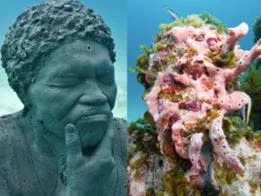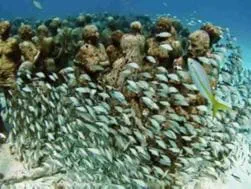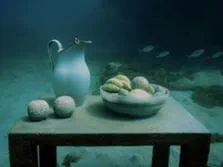Dive into the Art of Jason deCaires Taylor
Student Stories
02/11/2021
When is art more than simply something to look at? How about when it makes a positive impact on its environment, brings a community together, and alerts scientists to climate change. These are a few ways Jason deCaires Taylor transforms his underwater sculptures into much more than art installations. He showed us how during the last Meeting with Remarkable Men and Women.
Taking Art to a New (Sea) Level
Artists usually see their creations as something more than what meets the eye. Even though art is subjective, there’s a deeper meaning beyond the tangible. For Jason, the meaning lies in what his work adds to a space. “It doesn’t really matter what the artwork is like or if people like them…what’s most important is that now there’s these areas where there’s a lot of life where previously was devoid of life.” What’s even more unique is that these areas now teeming with life are underwater.

Jason combines his passions for art and the environment by creating large-scale underwater “museums” encompassing over 850 life-size sculptures. These creations span several continents and explore themes of conservation and activism. Not only are these sculptures environmentally friendly, they’re made from materials that generate natural growth. They attract fish, sponges, and coral production to be environmentally stimulating.
Who would have thought a collection of sculptures could become a National Marine Protected Area and listed as one of the Top 25 Wonders of the World by National Geographic? Not Jason, not at first.
Creating a World of Change

Back in 1993 when Jason was studying art in London, he enjoyed working outdoors and creating art in various urban landscapes. He was inspired by how his work changed over time when placed in various environments—not only physically but contextually too. The elements created a sort of camouflage on his creations as they adapted to their new surroundings—much like how all living things grow, change, and adapt over time. Even though there was no class in creating art underwater, by witnessing these changes, Jason was inspired to start submerging his sculptures.
One of his first oceanic projects came after Hurricane Ivan devastated island communities. Jason wanted to make a positive impact and not cause further damage to delicate coral reefs. So he started creating casts of different people and watched how these sculptures not only attracted sea life, but also drew the tourists away from the ravaged reefs to marvel at the underwater museum.

By fashioning the figures after members of the local community—everyone from yoga instructors and fishermen to nuns and a two-year old boy—Jason gave them a further sense of ownership to their reefs, since their likenesses became part of the reefs themselves. After a few days underwater, green algae formed on the sculptures. After a year, large schools of fish were comfortable enough to hide between the community of sculptures and call it home.
Art is Life

By creating underwater sculpture gardens, Jason gave us a new way of looking at art. Even a basic still-life subject transformed from a 2D representation into a transformative 3D project. Artistic elements of light, color, and scale took on new meanings in this new environment. Plus, instead of walking through a gallery and taking in a painting from one angle, art lovers are able to swim around a piece and gain a new perspective each time they visit.
Even the pieces themselves take on a life of their own. When a sponge grows on sculpture, it inhales water, literally breathing life into its host. Certain sea life acts as hair, skin, and other physical characteristics of a character. Fan coral delicately waves with the movement of the water, adding a kinetic energy to its subject. Carefully designed sculptures solve certain issues, like creating a space for lobsters to live and hide from poachers or changing colors to help scientists monitor coral temperatures.
Whether the sculptures are made to bring more attention to certain world issues or simply provide an artistic escape, Jason taught us that art can certainly make a difference. His underwater museums are a place where art truly lives and allows people to look at the ocean as more than a body of water but a sacred space to explore.






















Share on social media